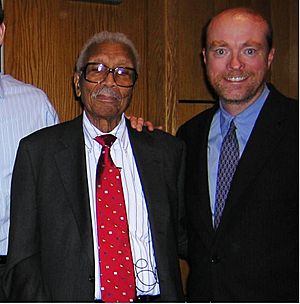Sweatt v. Painter facts for kids
Quick facts for kids Sweatt v. Painter, et al. |
|
|---|---|

|
|
| Argued April 4, 1950 Decided June 5, 1950 |
|
| Full case name | Heman Marion Sweatt v. Theophilus Shickel Painter |
| Citations | 339 U.S. 629 (more)
70 S. Ct. 848; 94 L. Ed. 1114; 1950 U.S. LEXIS 1809
|
| Prior history | Cert. to the Supreme Court of Texas |
| Holding | |
| Segregation as applied to the admissions processes for law school in the United States violates Equal Protection Clause of the Fourteenth Amendment, because separate facilities in legal education are inherently unequal. Texas Supreme Court reversed. | |
| Court membership | |
| Case opinions | |
| Majority | Vinson, joined by unanimous |
Sweatt v. Painter was a very important case decided by the U.S. Supreme Court in 1950. This case successfully challenged the idea of "separate but equal" schools for different races. This idea had been allowed since an 1896 case called Plessy v. Ferguson. The Sweatt v. Painter decision helped pave the way for the even more famous Brown v. Board of Education case just four years later.
The case was about Heman Marion Sweatt, an African American man. He was not allowed to join the Law School at the University of Texas. The president of the university at the time was Theophilus Painter. Sweatt was denied admission because the Texas State Constitution said that black and white students could not go to school together. The Supreme Court made its decision on the same day as another similar case, McLaurin v. Oklahoma State Regents.
Contents
The Fight for Equal Education
This section explains how Heman Sweatt tried to get into law school. It also covers the legal steps he took.
Why Did Heman Sweatt Sue?
Heman Sweatt wanted to become a lawyer. He applied to the University of Texas Law School. However, he was turned away because he was Black. At that time, many states had laws that kept Black and white people separate. This was called "segregation."
The Case Goes to Court
Sweatt decided to sue. He wanted the court to order his admission to the University of Texas Law School. The local court in Travis County, Texas, did not immediately grant his request. Instead, it gave the state six months to create a separate law school for Black students.
This new "separate" law school was set up in Houston. It was not in Austin, where the main University of Texas was located. This school later became the Thurgood Marshall School of Law at Texas Southern University.
The Dean of the Law School, Charles T. McCormick, supported having a separate school for Black students. The Texas Attorney General, Price Daniel, also strongly supported racial segregation.
Reaching the Supreme Court
Sweatt lost his case in the lower Texas courts. He and the NAACP then took his fight to the federal courts. Eventually, the case reached the highest court in the country, the U.S. Supreme Court. Robert L. Carter and Thurgood Marshall were the lawyers who argued Sweatt's case.
The U.S. Supreme Court's Decision
The Supreme Court looked at the differences between the two law schools. They decided that the separate school for Black students was not equal.
Why Was the Separate School Unequal?
The Court found many reasons why the separate law school was not truly equal. They looked at things like the number of teachers and books. They also considered the overall experience students would get.
Here are some of the differences the Court found:
- The University of Texas Law School had 16 full-time and 3 part-time professors. The Black law school had only 5 full-time professors.
- The University of Texas Law School had 850 students. Its law library had 65,000 books. The Black law school had only 23 students and 16,500 books.
- The University of Texas Law School had special facilities for practicing court cases (called moot court). It also had a strong network of graduates who were successful lawyers. The Black law school had only one practice court facility. Only one of its graduates had become a lawyer in Texas.
The Supreme Court said that for graduate education, the overall experience matters. Being isolated from other future lawyers made the separate school unequal. They ruled that "separate" facilities in legal education could not truly be "equal."
Lasting Impact of the Case
The Supreme Court's decision in Sweatt v. Painter was a big step forward. It helped to weaken the "separate but equal" rule. This case showed that even if facilities seemed similar, they could still be unequal. This was especially true when it came to the quality of education and opportunities.
This ruling was very important for the future of civil rights in America. It helped set the stage for the Brown v. Board of Education case in 1954. That case finally ended legal segregation in public schools across the United States.
In 2005, the courthouse in Travis County, Texas, was renamed. It is now called The Heman Marion Sweatt Travis County Courthouse. This was done to honor Sweatt's brave fight and his victory for equal rights.


